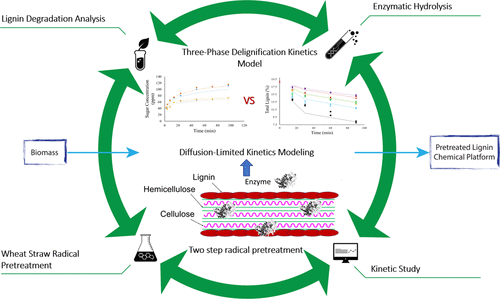当前位置:
X-MOL 学术
›
Ind. Eng. Chem. Res.
›
论文详情
Our official English website, www.x-mol.net, welcomes your
feedback! (Note: you will need to create a separate account there.)
Delignification and Enzyme-Diffusion Kinetics of Radical Systems Treating Wheat Straw
Industrial & Engineering Chemistry Research ( IF 3.8 ) Pub Date : 2020-11-11 , DOI: 10.1021/acs.iecr.0c04107 Maryam Davaritouchaee 1, 2 , Shulin Chen 1, 3 , Rock J. Mancini 1, 2
Industrial & Engineering Chemistry Research ( IF 3.8 ) Pub Date : 2020-11-11 , DOI: 10.1021/acs.iecr.0c04107 Maryam Davaritouchaee 1, 2 , Shulin Chen 1, 3 , Rock J. Mancini 1, 2
Affiliation

|
Biomass pretreatment is often evaluated based on the degree of delignification and the yield of enzymatic hydrolysis. Thus, the phase delignification and enzyme diffusion kinetics models were utilized to describe the deconstruction mechanism of wheat straw treated with two-step radical oxidation. The oxidation started with a superoxide radical anion, followed by a second radical treatment that synergizes the advantages of both radical systems. Two-step superoxide radical anion and two-step superoxide-hydroxyl radical pretreatments were the most effective pretreatment based on the degree of lignin removal and sugar release. These treatments resulted in 65 and 46% decrease in lignin content and 85.75 and 73.96% increase in glucan recovery, respectively. The delignification kinetics constants, k1, k2, and k3, were found to be 1.950, 1.085, and 1.085 min–1, respectively, for two-step pretreatment with superoxide radicals and 1.094, 0.717, and 0.717 min–1 with superoxide-hydroxyl radical pretreatment, whereas the kinetics constants were 0.485, 0.390, and 0.390 min–1 for the control. The structural diffusion resistance constant, n, was 0.205–0.359 for the control and 0.185–0.305 for the one-step superoxide treatment, 0.114–0.304 for two-step superoxide treatment, and 0.179–0.249 for two-step superoxide-hydroxyl radical treatment. These results justify that high lignin removal does not always contribute to a better enzymatic hydrolysis rate, likely because oxidized lignin products on the surface of biomass can restrict enzyme accessibility.
中文翻译:

自由基处理麦草的去木质素和酶扩散动力学
通常基于脱木素度和酶促水解的产率来评估生物质预处理。因此,利用相去木质素和酶扩散动力学模型描述了两步自由基氧化处理麦秸的解构机理。氧化开始于超氧自由基阴离子,然后进行第二次自由基处理,使两个自由基系统的优点协同作用。基于木质素去除和糖释放的程度,两步超氧自由基阴离子和两步超氧羟基自由基预处理是最有效的预处理。这些处理分别导致木质素含量减少65%和46%,葡聚糖回收率分别增加85.75和73.96%。脱木质素动力学常数k 1,对于使用超氧自由基的两步预处理,发现k 2和k 3分别为1.950、1.085和1.085 min –1,以及使用超氧化物-羟基自由基的预处理分别为1.094、0.717和0.717 min –1,而动力学常数分别为0.485、0.390和0.390 min –1。结构扩散阻力常数n对照为0.205–0.359,一步超氧化物处理为0.185–0.305,两步超氧化物处理为0.114–0.304,两步超氧化物-羟基自由基处理为0.179–0.249。这些结果证明,木质素的高去除并不总是有助于提高酶的水解速度,这可能是因为生物质表面的氧化木质素产物会限制酶的可及性。
更新日期:2020-11-25
中文翻译:

自由基处理麦草的去木质素和酶扩散动力学
通常基于脱木素度和酶促水解的产率来评估生物质预处理。因此,利用相去木质素和酶扩散动力学模型描述了两步自由基氧化处理麦秸的解构机理。氧化开始于超氧自由基阴离子,然后进行第二次自由基处理,使两个自由基系统的优点协同作用。基于木质素去除和糖释放的程度,两步超氧自由基阴离子和两步超氧羟基自由基预处理是最有效的预处理。这些处理分别导致木质素含量减少65%和46%,葡聚糖回收率分别增加85.75和73.96%。脱木质素动力学常数k 1,对于使用超氧自由基的两步预处理,发现k 2和k 3分别为1.950、1.085和1.085 min –1,以及使用超氧化物-羟基自由基的预处理分别为1.094、0.717和0.717 min –1,而动力学常数分别为0.485、0.390和0.390 min –1。结构扩散阻力常数n对照为0.205–0.359,一步超氧化物处理为0.185–0.305,两步超氧化物处理为0.114–0.304,两步超氧化物-羟基自由基处理为0.179–0.249。这些结果证明,木质素的高去除并不总是有助于提高酶的水解速度,这可能是因为生物质表面的氧化木质素产物会限制酶的可及性。









































 京公网安备 11010802027423号
京公网安备 11010802027423号